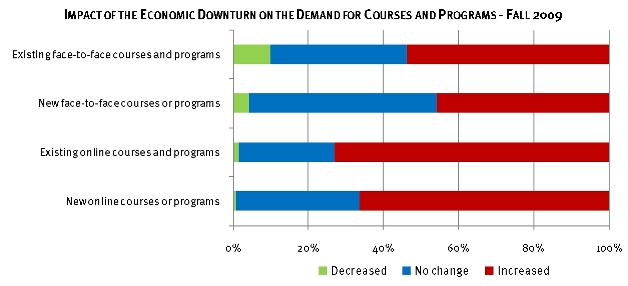2009 - Learning on Demand: Online Education in the United States
Learning on Demand: Online Education in the United States, 2009 represents the seventh annual report on the state of online learning in U.S. higher education. This year’s study, like those for the previous six years, is aimed at answering some of the fundamental questions about the nature and extent of online education. Supported by the Alfred P. Sloan Foundation and based on responses from more than 2,500 colleges and universities, the study addresses the following key questions:
How Many Students are Learning Online?
Background: For the past six years, online enrollments have been growing substantially faster than overall higher education enrollments. The expectation of academic leaders has been that these enrollments would continue their substantial growth for at least another year. Do the measured enrollments match these lofty expectations?
The evidence: Online enrollments have continued to grow at rates far in excess of the total higher education student population, with the most recent data demonstrating no signs of slowing.
- Over 4.6 million students were taking at least one online course during the fall 2008 term; a 17 percent increase over the number reported the previous year.
- The 17 percent growth rate for online enrollments far exceeds the 1.2 percent growth of the overall higher education student population.
- More than one in four college and university students now take at least one course online.
What is the Impact of the Economy on Online Education?
Background: Bad economic times have historically been good for higher education enrollments, either because the decreased availability of good jobs encourages more people to seek education, or because those currently employed seek to improve their chances for advancement by advancing their education.
The evidence: Academic leaders at all types of institutions report increased demand for face-to-face and online courses, with those at public institutions seeing the largest impact. In all cases the demand for online offerings is greater than that for the corresponding face-to-face offerings.
- Over one-half (54 percent) of institutions report that the economic downturn has increased demand for existing face-to-face courses.
- The economic impact has been greatest on demand for online courses, with 66 percent of institutions reporting increased demand for new courses and programs and 73 percent seeing increased demand for existing online courses and programs.
- The economic impact on institutional budgets has been mixed; 50 percent have seen their budgets decrease as a result, but 25 percent have experienced an increase.
What Contingency Plans do Institutions Have for H1N1?
Background: A series of questions about the effect of the H1N1 on institutions and the extent and type of contingency plan were asked of chief academic officers. Of particular interest is the use of online as part of the contingency plan.
The evidence: Proponents of online learning have long posited that moving face-to-face classes online could become an important component of academic continuity planning. A potential H1N1 pandemic is such an event that might trigger such planning.
- Over two-thirds of institutions report that they have a formal contingency plan in place to deal with a possible disruption from the H1N1 flu.
- Substituting online for face-to-face classes is a component of 67 percent of H1N1 contingency plans.
- Twenty percent of institutions with no current online offerings include introducing online classes as part of their contingency plans.
Is Online Learning Strategic?
Background: Last year’s report showed a very small decline in the number of chief academic officers declaring online education as critical to their continued growth. Is there a continued decline in 2009?
The evidence: This year’s results show a very small increase from the previous year and begin to signal that a plateau may have been reached by institutions believing that online is critical to their long-term strategy.
- The proportion of institutions that see online education as a critical component of their long-term strategy appears to have reached a plateau over the past several years.
- Baccalaureate institutions continue to be the least likely to consider online to be strategic, with only 33 percent agreeing.
- Public institutions (74 percent) are more likely to believe that online is critical for their long-term strategy than either private for-profit (51 percent) or private nonprofit (50 percent) institutions.
Has Faculty Acceptance of Online Increased?
Background: The perception of chief academic officers of faculty acceptance of online teaching and learning has changed little in the last six years.
The evidence: While the number of programs and courses online continue to grow, the acceptance of this learning modality by faculty has been relatively constant since first measured in 2002.
- Less than one-third of chief academic officers believe that their faculty accept the value and legitimacy of online education. This percent has changed little over the last six years.
- The proportion of chief academic officers that report their faculty accept online education varies widely by type of school but reaches a majority in none.
Do Faculty Receiving Training for Teaching Online?
Background: For faculty teaching online the type of pedagogy used may differ significantly from face-to-face classes. The growth of online courses and programs has increased the need for faculty to become comfortable with online teaching and gain the necessary skills to make online courses a success.
The evidence: There is no one approach being taken by institutions in providing training for their teaching faculty. Most institutions use a combination of mentoring and training options.
- Only 19 percent of institutions with online offerings report that they have no training or mentoring programs for their teaching faculty.
- The most common training approaches for online faculty are internally run training courses (65 percent) and informal mentoring (59 percent).


